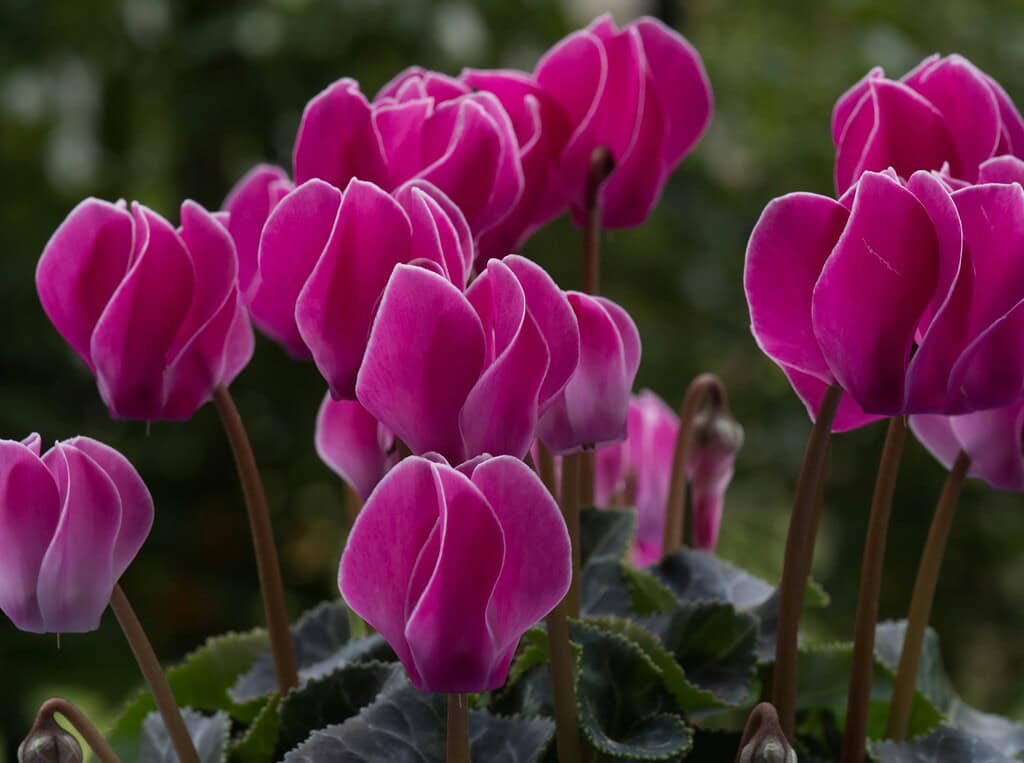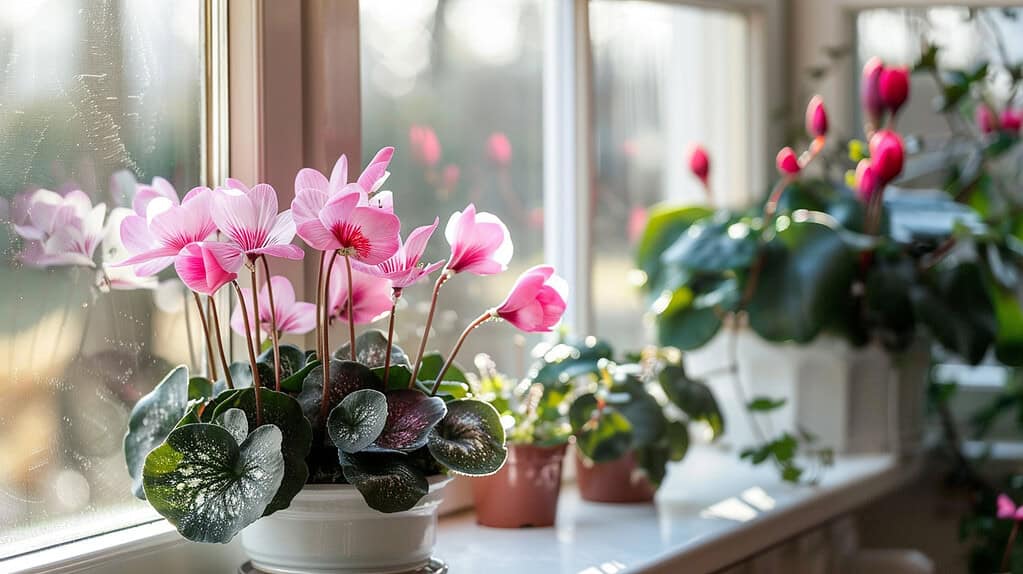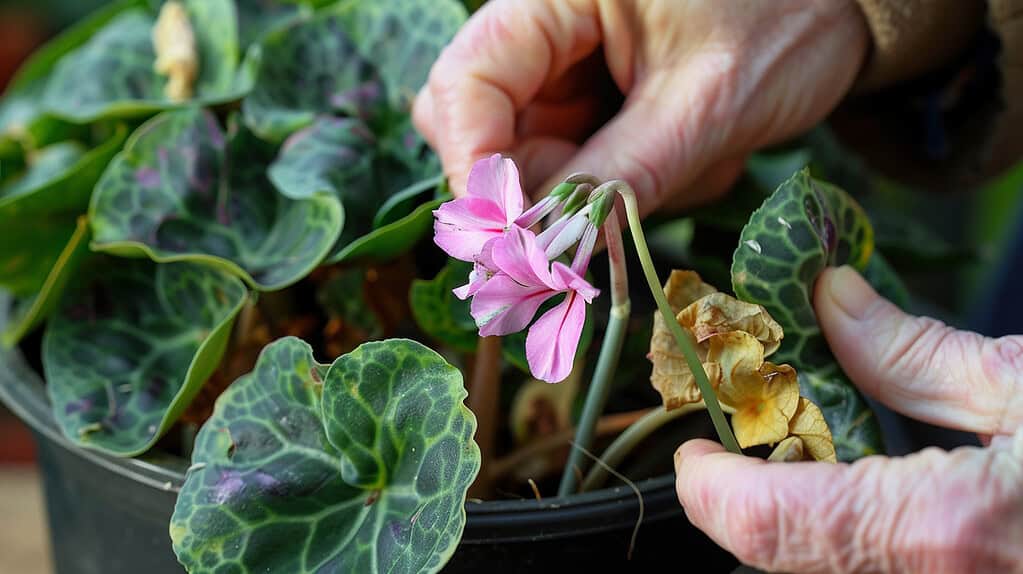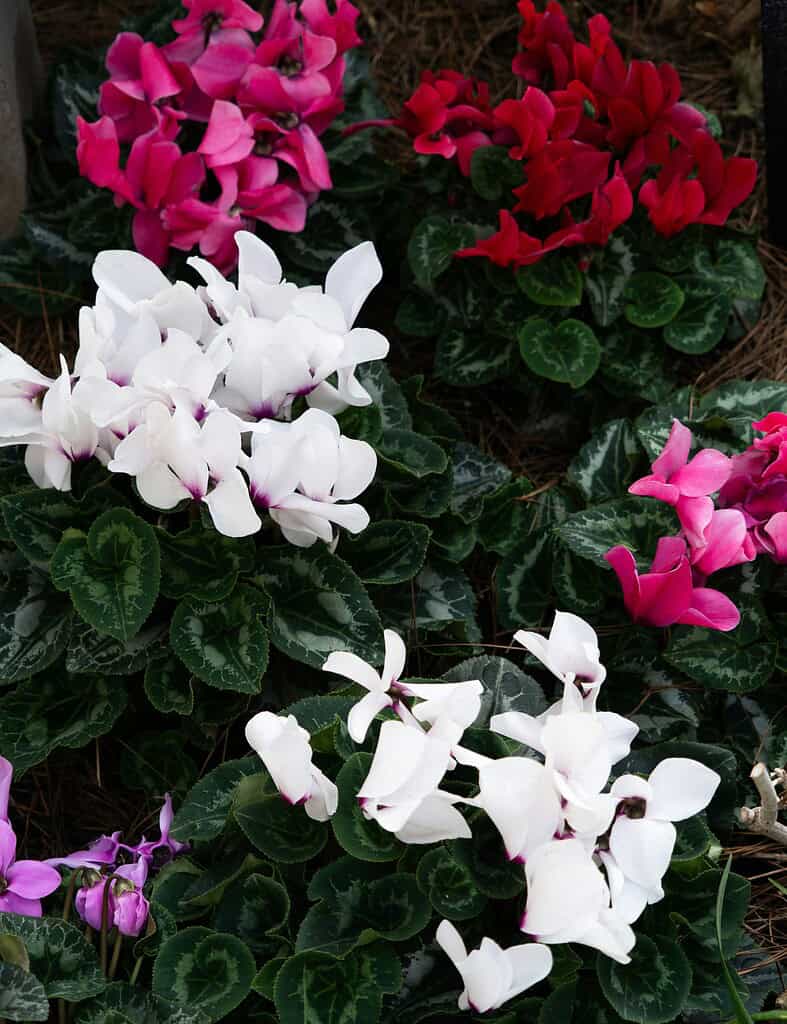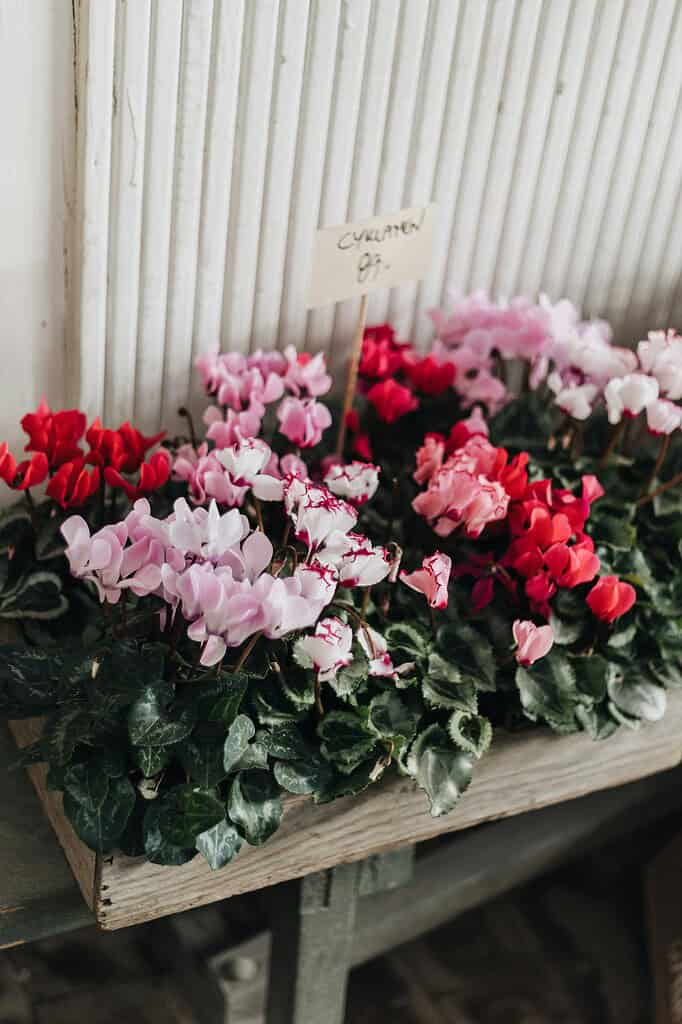Cyclamen flowers are cool-season favorites known for their vibrant petals and marbled leaves.
Whether grown indoors as houseplants or outdoors in mild climates, they offer long-lasting color during the fall and winter months.
While often seen as temporary holiday decor, cyclamen can thrive and rebloom with the right care.
In this article, I'll cover everything you need to know – from choosing a healthy plant and proper watering techniques to encouraging dormancy and successful reblooming – so you can enjoy beautiful cyclamen year after year.
If you love keeping your home filled with vibrant seasonal plants, you'll also find our guide on how to grow and care for poinsettias equally helpful!
Cyclamen Plant Profile
| Feature | Details |
|---|---|
| Botanical Name | Cyclamen spp. |
| Other Names | Persian violet, Sowbread |
| Family | Primulaceae (primrose family) |
| Plant Habit | Tuberous perennial |
| Size | Typically 6 to 12 inches tall and wide (varies by species) |
| Light Needs | Bright, indirect light indoors; partial shade outdoors |
| Soil Preference | Well-drained, slightly acidic; rich in organic matter |
| pH Range | Slightly acidic (5.5–6.5) |
| Bloom Season | Fall through early spring (varies by species and indoor/outdoor conditions) |
| Flower Colors | Pink, red, white, purple, magenta (depends on cultivar) |
| Hardiness Zones | USDA zones 5–9 for hardy types (varies by species) |
| Native Range | Europe, the Mediterranean, and parts of western Asia |
How to Choose a Healthy Cyclamen Plant
Buying a healthy cyclamen is the first step to keeping it alive and blooming for as long as possible.
When selecting a plant, there are a few specific things to look for that can help ensure a longer flowering period and fewer issues with disease or rot.
Look for Unopened Buds for Longer Blooming
Choose a plant with several tight buds clustered in the center, rather than one that is already in full bloom.
Bud-heavy plants will continue to flower over a longer period once brought home. A plant already in full bloom may be near the end of its flowering cycle.
Check for Firm, Healthy Leaves
Inspect the leaves carefully. They should be firm, slightly succulent, and evenly colored with no soft spots or signs of yellowing.
Avoid plants with drooping foliage or leaves with brown or discolored edges, as these may indicate root rot or stress from overwatering.
Selecting Fragrant Cyclamen Varieties Like ‘Scentsation’
If you're looking for added fragrance, gently smell the plant before buying. Some miniature varieties, including the ‘Scentsation' type, have a mild, pleasant scent.
Not all cyclamen are fragrant, so this is something to check in person if scent is important to you.
How to Grow Cyclamen Indoors or Outdoors in 5 Steps
Growing cyclamen successfully starts with understanding how to plant them the right way. These plants grow from tubers and need specific conditions to root, grow, and eventually bloom.
Whether you're planting dry corms outdoors or potted tubers indoors, proper setup is key to a healthy plant.
1. Prepare the Right Pot and Soil
Use a pot that has good drainage holes. Cyclamen dislike sitting in waterlogged soil, which leads to tuber rot. For indoor planting, prepare a slightly acidic, well-draining soil mix. A good mix includes:
- 1 part peat moss or sphagnum peat
- 1 part perlite
- 1 part vermiculite or coarse sand
This mix ensures the roots get moisture and air while avoiding soggy conditions.
2. Plant the Tuber at the Correct Depth
When planting a tuber, make sure the top half of the tuber is exposed above the soil line. Do not bury it completely.
This helps prevent crown rot and allows air to circulate around the top of the tuber. If you’re planting for the first time, leave about 1 inch of space around the tuber inside the pot.
For outdoor hardy varieties, if you're planting dry corms, soak them in water for a few hours before planting. This encourages quicker rooting.
3. Water Properly After Planting
After planting, bottom water your cyclamen by placing the pot in a shallow tray of water for 10 to 15 minutes. Let the soil absorb moisture from the bottom up.
This protects the exposed tuber from rot caused by top-watering. Once the soil is evenly moist, remove the pot and allow it to drain completely.
Avoid watering again until you see the foliage begin to grow or the soil starts to dry slightly.
Need tips on watering indoor plants? Check out our comprehensive guide on how to water plants indoors for expert advice that applies to all your favorite plants, including cyclamen!
4. Provide the Ideal Environment
Cyclamen grow best in cool, bright conditions.
Indoors, place them near a window where they receive bright but indirect sunlight. Avoid placing them near heat sources or in direct sun, which can cause stress.
The ideal temperature range is 50–65°F (10–18°C). Outdoor planting should happen in locations that receive winter sun and summer shade, such as under deciduous trees.
5. Start Fertilizing Once Leaves Appear
Wait until you see leaf growth before fertilizing.
Use a low-nitrogen liquid fertilizer that supports blooming rather than foliage growth. Follow the instructions on the label for dilution and apply every few weeks during the active growing season.
Avoid feeding during dormancy or immediately after planting, as the plant is not yet ready to absorb nutrients.
If you’re also growing edibles, you might like this guide on natural fertilizer for veggies to keep your kitchen garden thriving.
Best Location and Display Tips for Cyclamen Plants
Choosing the right spot for your cyclamen is just as important as proper watering and soil. These plants prefer cool temperatures, indirect light, and some protection from heat.
With the right placement, they’ll not only thrive but also serve as a decorative element in your home or garden.
Light and Temperature Requirements for Healthy Growth
Cyclamen do best in bright, indirect light. Indoors, an east- or north-facing windowsill is ideal.
Avoid harsh direct sunlight, especially in the afternoon, as it can scorch the leaves and dry the soil too quickly.
Outdoors, cyclamen prefer partial shade – bright morning light is fine, but they should be shielded from intense midday and afternoon sun.
In fact, they pair beautifully with other shade-friendly bloomers like camellias, so if you’d like a companion plant, here’s how to grow camellias flower successfully.
In mild climates, plant them under deciduous trees, where they’ll get winter light and summer shade.
As cool-weather plants, cyclamen thrive in temperatures between 50°F and 65°F (10°C–18°C). If the room gets too warm, flowering will stop, and the plant may enter dormancy early.
Keep them away from radiators, heating vents, and sunny windows.
Decorative Uses for Cyclamen Leaves and Foliage
Cyclamen aren't just grown for their flowers. The silver or grey-green marbled leaves are highly ornamental and can be used creatively in home decor.
Historically, cyclamen foliage was used in orchid corsages because of its unique patterns and colors.
You can use these leaves as accents in seasonal floral arrangements or even display non-blooming cyclamen just for the foliage alone.
They’re also excellent for decorating tabletops, window ledges, or entryways during cooler months.
In shaded garden areas, hardy cyclamen varieties add texture and ground-level interest even when not in bloom.
How to Water Cyclamen the Right Way
Watering cyclamen correctly is one of the most important parts of keeping the plant healthy.
Since the tuber sits close to the soil surface, using the wrong method can easily lead to rot. Instead of following a rigid schedule, observe the plant and soil closely to decide when and how to water.
Bottom Watering Prevents Root Rot
Cyclamen tubers are highly prone to rotting if they stay wet on top. For this reason, bottom watering is the safest and most effective method.
To bottom water:
- Fill a shallow tray or bowl with clean, room-temperature water.
- Place the pot in the tray and let it sit for 10 to 15 minutes.
- Once the top layer of soil feels slightly moist, remove the pot.
- Let it drain completely before placing it back in its usual spot.
This method keeps moisture away from the tuber’s crown and prevents fungal issues that often arise with top watering.
Avoid misting or watering directly on the leaves, stems, or tuber, especially when the plant is dormant or in cool conditions.
How to Use the Wilt Test to Know When to Water
Cyclamen don’t need frequent watering, especially in cooler temperatures. Instead of sticking to a schedule, use the wilt test to guide you.
Check the leaves:
- If they are upright and firm, the plant has enough moisture.
- If they appear soft or slightly drooping, it’s a sign the plant needs water.
This subtle change in leaf posture is an accurate way to time your watering without overdoing it.
How to Fertilize Cyclamen for More Blooms
Cyclamen are not heavy feeders, but the right kind of fertilizer at the right time can help them produce more flowers and stay healthy during their growing season.
The key is using a formula that supports blooms without encouraging excessive leaf growth.
Choose a Low-Nitrogen Fertilizer for Flowering
To support blooming, use a low-nitrogen liquid fertilizer. Fertilizers with high nitrogen content promote leaf growth at the expense of flowers, which is not ideal for cyclamen.
Look for labels marked as:
- Bloom booster
- Formulated for flowering houseplants
- Or use a general-purpose fertilizer diluted to half strength, as long as the nitrogen content is lower than the phosphorus and potassium (e.g., 5-10-10 or 10-15-10).
Avoid slow-release fertilizers, which can deliver inconsistent nutrients over time and may lead to overfeeding.
Feeding Schedule During the Blooming Season
Only begin fertilizing after new leaf growth appears and the plant is clearly active. During the growing and blooming phase, feed once every 2 to 4 weeks.
Stop feeding entirely once the plant begins to enter dormancy (leaves yellow or die back), as it no longer absorbs nutrients.
Continuing to fertilize during this period can damage the tuber or interrupt the plant’s natural rest cycle.
Feeding too often or using high-strength fertilizer can also increase the risk of disease and make it harder for the plant to rebloom the following season.
Looking for great fertilizer options for other plants? Check out our guide on the best organic slow-release fertilizers, perfect for nourishing your garden the natural way!
How to Prune Cyclamen Without Damaging the Plant
Cyclamen don’t need heavy pruning, but removing spent flowers and yellowing leaves is important for maintaining plant health and preventing rot.
Instead of using scissors or snipping tools, cyclamen respond better to a more direct method that removes the growth cleanly from the base.
The Twist-and-Pull Method for Dead Leaves and Flowers
When a bloom fades or a leaf begins to yellow, it’s best to remove it as soon as possible. The most effective way to do this is the twist-and-pull method:
- Grasp the stem close to the base of the plant.
- Twist it gently until you feel it loosen.
- Pull sharply to remove the entire stem from the tuber.
This ensures the whole stem comes out cleanly, which helps prevent moisture from being trapped in decaying plant material – a common cause of tuber rot.
Avoid cutting stems with scissors, as this can leave a small stub behind that becomes a rot point.
How Regular Pruning Helps Prevent Disease
Removing fading flowers and declining leaves not only keeps the plant tidy, it also reduces the chance of fungal growth and mold, especially in cool, damp conditions.
Pruning also helps redirect the plant’s energy toward new blooms and healthy foliage.
During the flowering season, check your cyclamen every few days and remove any stems that are starting to decline.
How to Make Cyclamen Bloom Again After Dormancy
Cyclamen go dormant after their blooming season ends, often causing concern for first-time growers.
But this is a natural part of the plant's life cycle. With proper handling during dormancy, cyclamen can rebloom for several years.
Understanding the Cyclamen Dormancy Cycle
Most cyclamen enter dormancy in late spring or early summer, after the blooming season finishes. This is marked by:
- Yellowing leaves
- Slowed or halted flower production
- Drying and dropping of foliage
This dormant phase is normal and allows the plant to rest before the next growth cycle. It typically lasts 6 to 12 weeks, depending on the variety and growing conditions.
How to Trigger Dormancy by Withholding Water
Once blooming has stopped and the leaves begin to fade, start gradually reducing water.
Over the next few weeks, let the soil dry out and stop watering completely once the leaves have fully withered and fallen off.
Do not feed or water the plant during dormancy. Keeping the soil too moist during this period can cause the tuber to rot.
Let the dormant tuber rest in its pot in a cool, dry location with good air circulation. Avoid areas with high humidity or extreme temperatures.
How to Store Cyclamen Tubers During Dormant Period
There are two ways to store cyclamen during dormancy:
- Leave it in the pot: Stop watering and place the pot in a cool area around 50°F (10°C). This is the simplest method.
- Store the tuber separately: For longer storage or repotting, you can remove the tuber from the soil, gently clean off the roots, and place it in dry vermiculite or peat moss. Store it in a breathable container in a cool, dark place.
After 6 to 12 weeks, begin checking for new growth. When small leaf buds appear, repot if needed, resume light watering, and gradually bring the plant back into brighter light.
When and How to Repot Cyclamen
Repotting cyclamen helps refresh the soil, prevent overcrowding, and keep the tuber healthy.
It’s not something you need to do every year, but it becomes important as the plant matures or when signs of decline appear in the current pot.
Signs That Your Cyclamen Needs Repotting
Repotting may be needed if you notice:
- Water draining too quickly or not at all
- Roots growing out of the drainage holes
- Soil that stays wet for too long or has compacted
- Tuber touching the edge of the pot
The best time to repot is during the dormant period, once the plant has finished flowering and the foliage has died back.
Best Soil Mix and Pot Size for Cyclamen Plants
Cyclamen need well-draining, slightly acidic soil. A suitable mix includes:
- 1 part sphagnum peat moss (for acidity)
- 1 part perlite
- 1 part vermiculite or coarse sand
Choose a pot that is only slightly larger than the tuber, leaving about 1 inch of space around it.
Make sure the pot has good drainage holes. Avoid oversized pots, which can retain excess moisture and increase the risk of rot.
For more detailed tips on creating the perfect soil for your plants, check out our complete guide to making the best potting soil mix, where you can learn how to customize the perfect blend for all your plants!
Correct Tuber Placement to Avoid Rot
Place the tuber in the center of the pot with its top half above the soil surface. Do not bury it completely.
The exposed upper portion allows air to circulate and helps prevent moisture buildup near the crown, which is a common cause of rot.
After planting, do not water immediately unless the tuber shows signs of new growth. Wait until early signs of sprouting appear, then resume bottom watering as needed.
How to Propagate Cyclamen Successfully
Cyclamen are not the easiest plants to propagate, but it is possible with care and patience.
Propagation can be done by dividing the tuber during dormancy or by planting dry corms for hardy outdoor varieties. Both methods carry some risk, particularly with rot, so technique matters.
Dividing Cyclamen Tubers During Dormancy
The best time to attempt tuber division is during the summer dormancy period, when the plant has no active growth.
To divide a tuber:
- Gently remove the tuber from the soil.
- Inspect it for natural offsets (small sections that have formed near the main tuber). If present, carefully break them off.
- If no offsets are present, you can cut the tuber into sections using a sterile, sharp knife. Each section must include at least one visible growth “eye” (a small bump or bud).
- Let the cut surfaces air dry briefly before planting to reduce the risk of rot.
Replant the sections in a well-draining, slightly acidic soil mix, keeping the top half of the tuber above the soil line.
Note: Cutting the tuber makes it vulnerable to infection. Not all divisions will succeed, so it’s best considered a low-success, high-risk method.
How to Prevent Rot in Divided Tuber Sections
To reduce the chances of rot:
- Avoid overwatering after planting
- Use bottom watering only once new growth appears
- Keep the pots in a cool, shaded location with good air circulation
- Consider using a fungicidal dust on cut surfaces before replanting
Propagation success improves when humidity and temperature are well controlled.
Planting Soaked Dry Corms Outdoors
For hardy cyclamen (especially Cyclamen hederifolium or Cyclamen coum), propagation can also be done by planting dry corms outdoors.
Before planting:
- Soak dry corms in water for a few hours to encourage root development.
- Plant in well-drained soil in a partially shaded spot.
- Position the corm with the top just beneath or slightly above the soil surface.
These outdoor types typically naturalize well and are suited for woodland gardens or shaded borders.
Keep Your Cyclamen Blooming Year After Year
Cyclamen may seem like delicate plants, but with the right approach, they are surprisingly long-lasting. Start with a healthy plant, use proper soil, and always keep water away from the tuber crown.
Whether you're growing them indoors for winter color or outdoors in shaded garden areas, cyclamen will reward you with months of blooms and attractive foliage.
Don’t discard them after flowering – learn their rhythm, allow for dormancy, and you can enjoy the same plant for many seasons.
They’re also wonderful companions to other tough winter flowers that can handle frost, giving your garden resilience and beauty through the cold months.
Have your cyclamen bloomed again? Got a tip that worked for you?
Comment down below and share your experience with other growers.
FAQs
1. How do I know if my cyclamen is dead or just dormant?
If your cyclamen has yellowing leaves and no new growth during warmer months, it's likely dormant – not dead. To confirm, gently feel the tuber. If it's firm and not shriveled or mushy, the plant is alive and resting. Resume care once new growth appears.
2. Can I grow cyclamen from seeds?
Yes, but it's slow. Cyclamen seeds can take 1–2 months to germinate and up to 18 months to reach blooming size. Sow seeds in moist, shaded conditions, and be patient. Most gardeners prefer buying tubers or established plants due to the long timeline.
3. What pests commonly affect cyclamen plants?
Cyclamen mites and aphids are the most common pests. Mites are nearly invisible but cause distorted leaves and stunted growth. Isolate affected plants and discard severely infested ones. Aphids can be managed with insecticidal soap or neem oil.
4. Can cyclamen be grown in water like some houseplants?
No. Cyclamen are tuberous and highly sensitive to overwatering. Growing them in water will lead to rot quickly. Always grow cyclamen in well-drained soil using a proper pot with drainage holes.
5. How do I revive a drooping cyclamen plant quickly?
If the leaves are soft and the soil feels dry, bottom water the pot immediately and let it soak for 10–15 minutes. If the soil is wet and the leaves are drooping, stop watering and allow it to dry out. Correct diagnosis is key to recovery.
Ready To Transform Your Garden?
Are you looking for the best way to layout your garden beds? Maybe you're feeling a bit stuck on how to make the most of your space?
We’ve got you covered! Check out our 101+ Garden Bed Layout Ideas for your next raised bed project. This guide is filled with creative and practical ideas that can help you design a garden that fits your style, whether you’re just starting out or have been gardening for years.
Get your copy today and get inspired to bring your gardening dreams to life.

